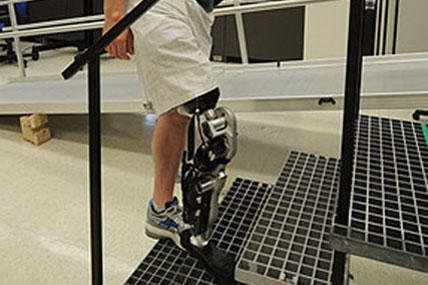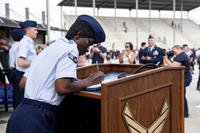Defense Department and academic researchers are hailing a significant breakthrough in the development of a mind-controlled bionic leg.
“We hope to … make this robust enough to send home with people for trial in three to five years,” said Levi Hargrove, a biomedical engineer and research scientist at the Rehabilitation Institute of Chicago. “After that, if it gets more funding, to have veterans at Walter Reed or San Antonio testing them.”
The institute’s achievement was made possible in part from an $8 million grant from the Defense Department, which has increased funding for prosthetics research over the past decade.
“A lot of people don’t realize that a lot of funding for this kind of research comes from DoD,” said Troy Turner, manager of the Advanced Prosthetics and Human Performance program at the Army Telemedicine and Advanced Technology Research Center at Fort Detrick, Md.
.
It’s easy to understand the Pentagon’s interest, especially after a decade of war that has resulted in more than 1,200 troops sustaining more than 1,600 amputations as of December 2012, according to a report from Brooke Army Medical Center in San Antonio.
“Historically, advances in prosthetics go with war,” Turner said.
This is the first time a prosthetic leg’s movement has been prompted and carried out by the signals from its owner’s brain -- a feat made possible by surgically connecting healthy nerves, RIC’s Hargrove said. Brain signals reach sensors attached to the leg and go on to the robotic leg’s computer. Software instantly analyzes and decodes the brain signals and converts them to instruction, which directs the limb to move in whatever way it needs.
Zac Vowter of Chicago, the patient who has been testing the mind-controlled bionic leg at RIC, described the difference between the prosthetic leg he has long used and the experimental one: “My sound leg goes up every step first, and I’m just dragging the prosthetic leg along behind me,” he said. “[But with the bionic leg] I go leg over leg. The bionic leg listens to the various signals from my nerves and responds in a much more natural way.”
The Pentagon’s aim is to develop a prosthetic that will help veterans live more fully outside the service, and give those servicemembers a chance to remain in service, he said.
“We have had more than a couple of folks who while military amputees have been able to redeploy, go back into theater,” Turner said.
Even if they do not deploy, the servicemember may want to rock climb, kayak, skydive or ride motorcycles. The Defense Department has funded projects aimed at letting servicemembers regain that athletic ability.
Engineers have developed ruggedized prosthetic knees and ankles that function in sand, mud and even water.
“We tend to refer to warfighters as ‘tactical athletes,' ” he said. “They perform at a higher level than most civilians; they have very high physical demands.”
Expectations for a prosthetic have evolved over the past few years as the technology improved significantly, Turner said.
“Now, it’s ‘how can we help you return to the highest level of functionality that you want?’ ” he said.



























